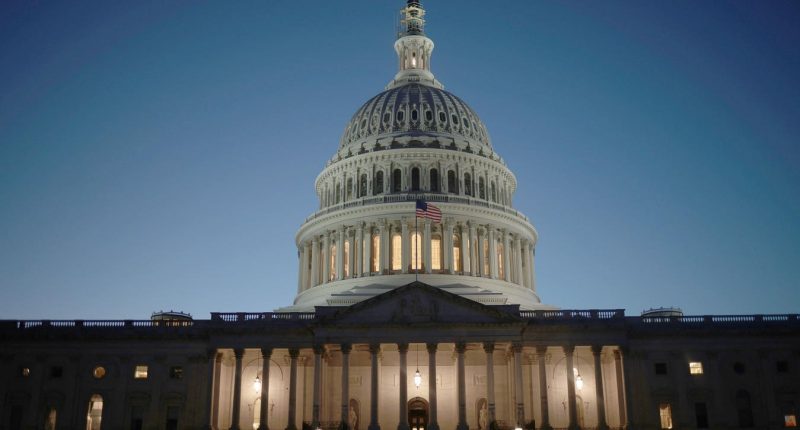Share this @internewscast.com
The “big, beautiful bill” is now back in the House, which will reconvene to take up the Senate-passed version Wednesday morning.
Getty Images
The Senate on Tuesday passed its version of President Trump’s “big, beautiful” tax and budget bill by a 51-50 vote, with Vice President JD Vance breaking the tie. The 940-page bill, which now returns to the House for final approval, contains a number of provisions related to higher education that seem likely to weaken nonprofit colleges’ finances, while making it more difficult for students to access financial aid and student loans. Although some House Republicans are complaining about Senate changes from the bill they passed back in May, the betting is that under pressure from Trump, they’ll accept the Senate’s version.
“With the goalpost of July 4th set by the President, it’s likely the Senate’s version will hold mostly intact,” says Michael Itzkowitz, founder of the higher education consultancy HEA Group and a former official in the Obama education department. “There’s just not too much time for the House to make any large changes at this point.” If House passage of the bill is delayed, it won’t be education-related provisions that hold it up, says Jon Fansmith, senior vice president for government relations and national engagement at the American Council on Education. The Senate bill’s deeper cuts to Medicaid and bigger increase in deficit spending may worry House Republicans, he says. “They may not be able to get this over the finish line tomorrow. And then if that doesn’t happen, I think everything goes back on the table,” says Fansmith. “But their goal is to try and move quickly.”
The proposals in the bill that impact college budgets fall into three big categories: endowment taxes, changes to Pell grants and regulatory repeals. It also contains a litany of changes to federal student loans, which would phase out popular income-driven repayment plans, limit borrowing by graduate students and parents, and eliminate economic hardship and unemployment deferment options, among other things. Forbes contributor Adam Minsky explains all of these changes in detail here. Read on for a breakdown of what else the bill has in store for higher ed.
On The College Endowment Tax
One of the biggest changes between the Senate bill and the House-passed version is a change to the excise tax proposal on the investment income of college endowments. The initial House-passed bill increased the existing 1.4% tax to as high as 21% for the richest institutions. The Senate bill scales that back, and outlines an excise tax structure that would levy an 8% tax on endowments worth more than $2 million per student, a 4% tax on endowments worth between $750,000 and $2 million per student, and a 1.4% tax on endowments worth between $500,000 and $750,000 per student. Colleges would only be subject to the tax if they enroll at least 3,000 tuition-paying students (up from the current cut-off of 500 students), and if at least half of those students are located in the United States. Unlike the House bill, the Senate version doesn’t punish schools for having a high number of foreign students by excluding them from the calculation of endowment per student. The Senate parliamentarian spiked the part of the proposal that would exempt religious institutions from the tax, which, Fansmith says, was part of an effort to exempt the very conservative Hillsdale College from the endowment tax. (Hillsdale would still be exempt from the tax because it enrolls less than 3,000 students).
Fansmith’s American Council on Education has always opposed an endowment tax. “It’s bad policy, it’s a bad idea. It’s taking money that was given to institutions for charitable purposes and giving it to the federal government, which basically means it’s not being used for the purposes it was given, which is financial aid support, research, things that people really want schools to spend their money on.”
On Pell Grants
The Senate bill would make some changes to students’ eligibility for Pell grants, the federal government scholarships offered to low-income students. The bill proposes that foreign income be included in the adjusted gross income calculation that’s used to determine students’ financial need, and it also proposes that, regardless of any other factors, students who can afford to pay at least double the maximum Pell grant award will no longer be eligible for a Pell grant. Another change: If a student receives enough non-federal grant aid to cover the full cost of college attendance for the term, they would no longer be eligible for a Pell grant even if they met the income requirements.
Notably, the final Senate version did not include changes to Pell eligibility requirements that would hurt low-income students and the institutions that enroll them, including a House-proposed change to the definition of a full-time credit load from 12 credits to 15 credits, and excluding less than half-time students from receiving any Pell dollars at all (which would have disqualified 700,000 students from the Pell program, a CBO analysis showed).
A proposal to create a workforce Pell grant squeaked into the final bill after the Senate parliamentarian ruled that it violated the rules of budget reconciliation. The final, Senate-approved version of H.R. 1 includes the workforce Pell proposal with one notable change: unaccredited institutions would not be allowed to receive Pell grant money.
The workforce Pell grant program would expand Pell grant access to students in short-term, eight to 15-week workforce training programs, even if they don’t lead to a formal degree or credential. Eligibility for the workforce Pell would be the same as the regular Pell grant—students must demonstrate “exceptional financial need,” which, for most recipients, is a household income of $60,000 or less each year. Students with any credentials beyond an undergraduate degree would not be eligible. According to the proposal, students would not be able to receive both a workforce Pell grant and a regular Pell grant, and the workforce Pell would contribute to a student’s lifetime Pell grant maximum, which is typically about six years of coursework. The short-term programs students enroll in must be state-approved and meet some federal requirements, including a 70% completion rate and 70% job placement rate. A workforce Pell grant would be a boon to for-profit colleges, which dominate the trade school and workforce training space. (Those which aren’t accredited would be excluded, however.)
On Regulatory Changes
In the section titled “regulatory relief,” the Senate bill repeals or weakens several regulations for higher education institutions. The 90/10 rule, which requires that for-profit colleges receive at least 10% of their revenue from non-federal sources, would revert to an earlier, more lenient version of the rule. The bill would completely eliminate the gainful employment rule, an Obama-era regulation that puts guardrails on for-profit colleges to ensure their students are prepared for employment and able to pay back their student loans. It would also spike the borrower’s defense to repayment regulations, instituted in 2022, which would make it more difficult for students to have their federal student loans canceled if they’ve been defrauded by their school.
“It’s no surprise that many student protections are on the chopping block,” says Itzkowitz. “First off, they were mainly put in place by Democratic administrations. Second of all, a more conservative Congress generally favors the idea of removing as many regulations as possible.”
The bill also delays 2022 regulations related to closed school discharges. Essentially, until 2035, students with federal loans whose colleges close will have a harder time getting those loans canceled.
New in the Senate version of the bill are strengthened accountability measures that require colleges to maintain good outcomes for students in order to be eligible for federal funding. According to the bill, “low-earning outcome programs” are defined as programs whose graduates’ median earnings are less than a comparable working adult, and such programs would not be eligible for federal funding. For bachelor’s institutions, a comparable working adult is described as someone aged 25 to 34 who is not currently in college and has only a high school diploma. For graduate institutions, a comparable working adult is a 25-to-34 year old who has only a bachelor’s degree.
“If a college program produces graduates who earn less than someone who never went to college, it would no longer receive federal funding. That’s a win-win for students and taxpayers,” Itzkowitz says. “However, it noticeably excludes certificate programs from any accountability. This is a huge policy omission, as certificates are often the riskiest credential for students, many of them being working adults, first-generation, or women of color.”
More From Forbes






